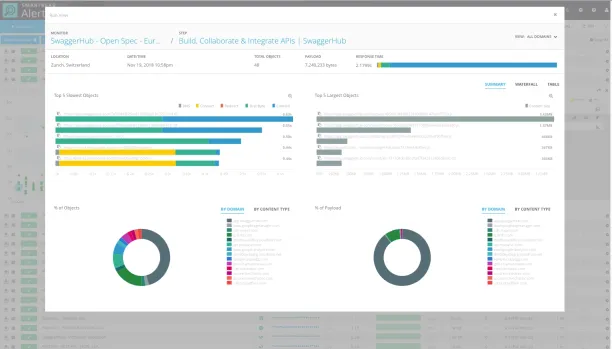Synthetic Monitoring: Definition, How-To, And Use Cases in 2024
Businesses want to ensure that their digital assets are always available and responsive. Synthetic monitoring is a technique to understand the performance of most critical business transactions and common paths in applications. With this method, businesses can foresee availability and performance issues in their digital systems and take action accordingly.
What is Synthetic Monitoring?
Synthetic monitoring (also known as directed monitoring) is a technique for tracking business application performance by simulating a path through the application. To do that, a route with different checkpoints is predefined. While the “synthetic” user goes through, these checkpoints provide performance metrics to ensure application availability. Wikipedia defines synthetic monitoring as follows:
Synthetic monitoring is a monitoring technique that is done by using emulation or scripted recordings of transactions. Behavioral scripts are created to simulate an action or route that a customer or end-user would take on a site, application, or other software. Those paths are then continuously monitored at specified intervals for performance, such as functionality, availability, and response time measures.
How does it work?
Synthetic monitoring involves checkpoints that the artificial user interacts with digital assets. In these checkpoints, it tracks predefined measures like functionality or availability, depending on the type of test. This technique consists of several steps depending on whether an error occurs.
- The test type (performance measures to track) and checkpoints are defined.
- The bot reaches a checkpoint; it initiates contact, checks responses, and continues to the next checkpoint.
- The bot reports responses and its findings to the monitoring system.
- If an error occurs, the system notifies related teams about the confirmed error based on the escalation settings and team schedules.
- At regular intervals, the records created during synthetic monitoring are purged. These include website analytics logs, new users and transactions completed by synthetic monitoring tools.
Depending on the type of test, the frequency might change from every minute to once an hour. According to Uptrends, a monitoring vendor, most brands check for availability every minute, performance every five minutes, and transactions every 15 minutes. Below you can find an example of synthetic monitoring interface.

Why is it important now?
3 factors are driving increased interest in synthetic monitoring: Customer focus of digital businesses, increased number of apps and increased value of transactions taking place on apps.
Modern digital businesses are now both software-driven and customer-focused. Since software performance is a critical determinant in customer experience and since synthetic monitoring is a novel and effective method to measure software performance, it is becoming more important.
As we explained before, number of applications are increasing. And the more applications you have, the higher the need for automated monitoring solutions since manual monitoring becomes less effective with more applications.
The value of digital operations is also growing. A technical problem in apps and websites might cause a loss of millions of customers. The e-commerce industry can be an example of the adverse effects of possible downtime. In 2018, Amazon was estimated to have lost between $72 million to $99 million because of an hour-long connectivity issue that its customers faced. If additional monitoring can reduce the probability of such events, businesses can justify the cost for additional monitoring.
What are its benefits?
Early identification leads to early issue resolution: Synthetic monitoring systems continuously collect performance measures like response time or load time. Early issue identifications thanks to monitoring help tems start working on problems earlier, leading to earlier resolution. If the values are problematic, synthetic monitoring provides shorter MTTR, since the problem detection will be faster.
Here are a few questions that a synthetic monitoring system can answer:
- Is my website up?
- How fast is my site at this moment?
- Are transactions working?
- Are third party components still operating?
- If there is a slow down or failure: where is it?
What are its use cases?
While synthetic monitoring tracks your application performance and availability, businesses can use this solution for overcoming different issues:
- Issue identification: While running an application or a website, companies can’t wait for their end-users to notify them of an availability or a performance issue. Synthetic monitoring enables businesses to detect those issues beforehand and prevents end-users from encountering them
- Testing from end-users’ perspective taking into account different devices/locations etc.: You can run your applications from different geographical locations, browsers, and devices with synthetic monitoring. With different scenarios, this solution provides insights into your end-user experience. For example, an e-commerce company can collect performance metrics for activities like logging in, searching, filling a form, adding items to cart and check out.
- Creating a baseline for performance trends: Synthetic monitoring collects all application performance data. Over time, according to your usual metrics, you can specify areas of improvement and define performance improvement strategies to enhance your current application performance.
- Detecting problems caused by third-party scripts: Third-party contents like advertising, payment management systems and CDNs affect the performance of the host site. Synthetic monitoring allows businesses to hold their third-party vendors accountable for their product’s availability and performance.
What are its alternatives?
The main problem with synthetic monitoring is that it uses predefined actions. It can’t predict real-user actions and may not follow the most common paths. Thus, synthetic monitoring might not detect any performance issues while real users encounter with availability problems on business applications.
On the other hand, real user monitoring (RUM) collects data from actual user transactions to detect issues like slowdowns or website errors. This technique is usually performed using a few lines of code within web pages, which collects relevant data and delivers it to you. It doesn’t lower application performance because it is usually agentless and asynchronous.
While RUM shows what is happening to users and provides real performance metrics, the downside is that users have to use the application for RUM to collect data. Without active website traffic, RUM can’t provide any data and notify businesses for performance issues. Thus, synthetic monitoring is an effective solution to test performance metrics without active traffic and detect problems before the end-users encounter them.
What are the types of synthetic monitoring?
Companies can run a wide range of tests to measure different techniques in their applications and websites. Below are the most common monitoring types that can be collected under synthetic monitoring.
- Availability Monitoring: Businesses encounter revenue loss, reputational damage, and severe distress when their applications or websites are down. Availability monitoring prevents these situations by checking if digital assets are accessible and functions appropriately. If it detects any issues, it notifies related teams before impacting end-users.
- Transaction Monitoring: Transaction monitoring is a technique for tracking customer transactions, including customer information and interactions, to provide a complete picture. The synthetic user goes through the predefined path that can log in to a service, complete forms, purchase products, and respond to system prompts.
- Web Performance Monitoring: Web Performance Monitoring checks the page load speed, shows performance on an element-by-element basis, and reports on frontend and backend response times for keeping everyone’s internet experience as smooth as possible.
What are the leading synthetic monitoring companies?
Most companies provide Application Performance Management (APM) services, along with synthetic mentoring. To have more information, you can also read our article about APM. Here are two vendors that are specialized in synthetic monitoring and can provide related services for your business.
- Smartbear provides a synthetic API monitoring called AlertSite for early warnings in your business applications and websites. The solution can also distinguish between real and false alerts via monitoring your UI and API layers and tracks application availability and performance 24/7 in real-time.
- Catchpoint can detect performance issues and identify their root-causes by providing a synthetic monitoring solution. You can shorten your MTTR and solve technical problems faster. It also helps you to understand your application infrastructure and how your page elements impact end-users.
If you have questions about how synthetic monitoring can help your business, we can help:

Cem has been the principal analyst at AIMultiple since 2017. AIMultiple informs hundreds of thousands of businesses (as per similarWeb) including 60% of Fortune 500 every month.
Cem's work has been cited by leading global publications including Business Insider, Forbes, Washington Post, global firms like Deloitte, HPE, NGOs like World Economic Forum and supranational organizations like European Commission. You can see more reputable companies and media that referenced AIMultiple.
Throughout his career, Cem served as a tech consultant, tech buyer and tech entrepreneur. He advised businesses on their enterprise software, automation, cloud, AI / ML and other technology related decisions at McKinsey & Company and Altman Solon for more than a decade. He also published a McKinsey report on digitalization.
He led technology strategy and procurement of a telco while reporting to the CEO. He has also led commercial growth of deep tech company Hypatos that reached a 7 digit annual recurring revenue and a 9 digit valuation from 0 within 2 years. Cem's work in Hypatos was covered by leading technology publications like TechCrunch and Business Insider.
Cem regularly speaks at international technology conferences. He graduated from Bogazici University as a computer engineer and holds an MBA from Columbia Business School.
To stay up-to-date on B2B tech & accelerate your enterprise:
Follow on

Comments
Your email address will not be published. All fields are required.